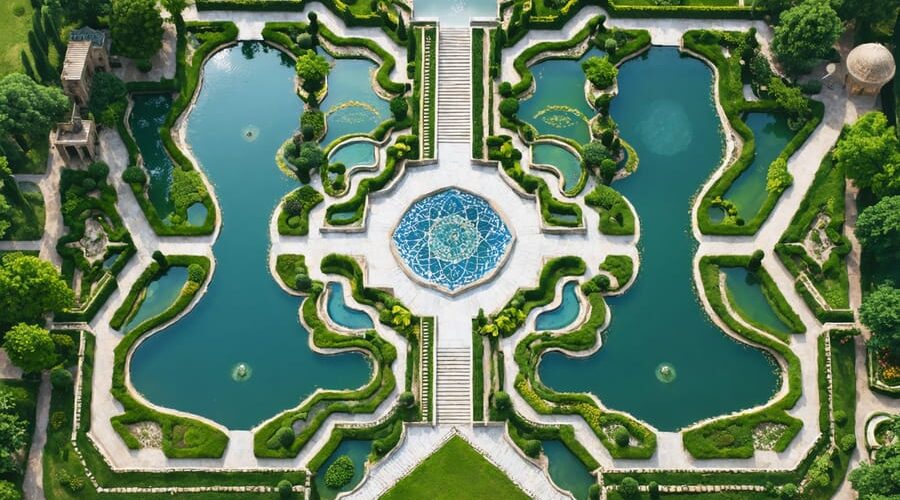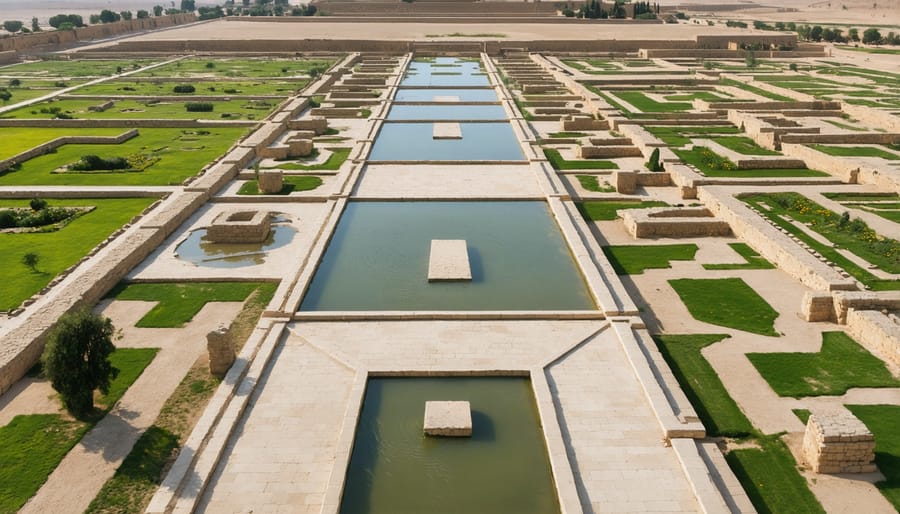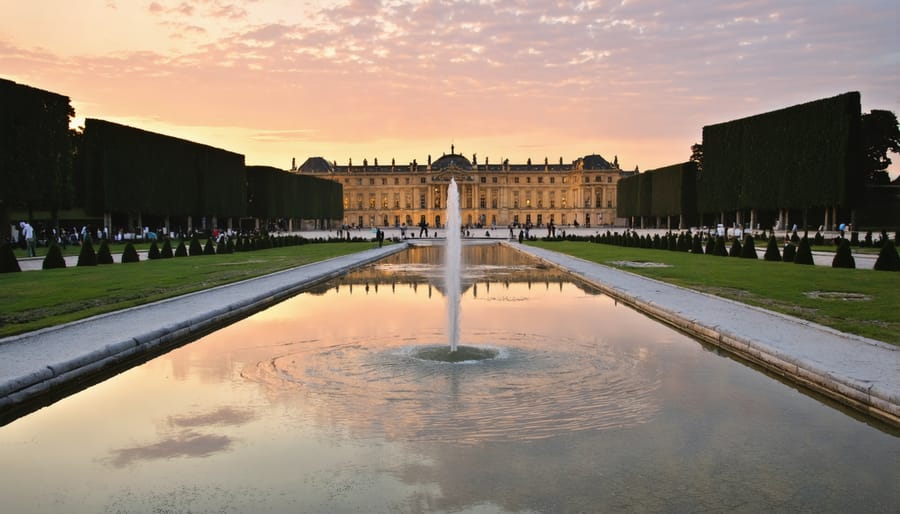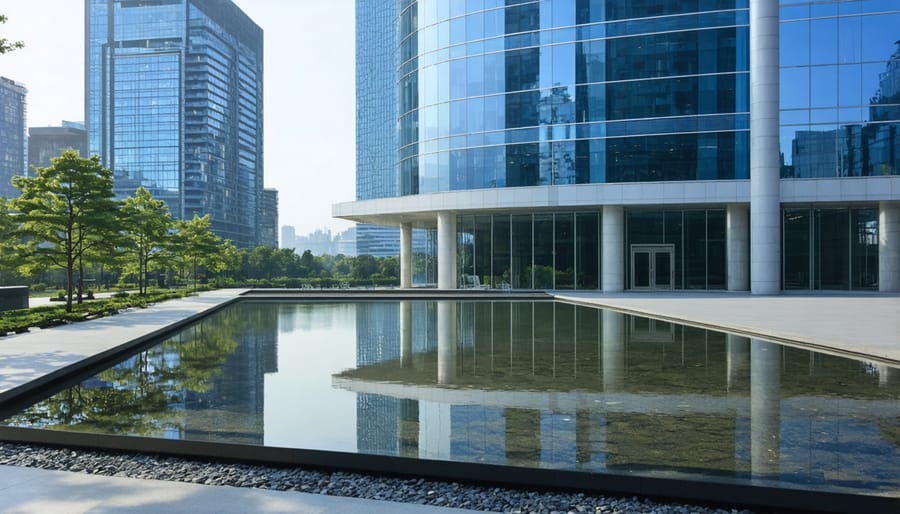
Water Gardens Through History: How Reflecting Pools Shaped Power and Society
Water speaks a language older than humanity itself, shaping our world and our understanding of it in profound ways. From the mesmerizing ripples of royal water gardens to the thunderous power of ocean waves, water embodies both tranquility and tremendous force. Its dual nature as life-giver and sculptor of landscapes has fascinated philosophers, scientists, and artists throughout history.
Consider how water exists in three states – solid, liquid, and gas – yet remains fundamentally unchanged in its essence. This remarkable substance follows patterns that both conform to and defy our expectations, creating surface tension strong enough to support insects while carving through solid rock over millennia. It serves as both mirror and window, reflecting our world above while revealing depths below.
In studying water, we ultimately study ourselves. Our bodies are primarily water, our civilizations have risen along its paths, and our future on this planet is inextricably linked to our understanding and stewardship of this essential element. Whether in a garden pond or vast ocean, water continues to teach us lessons about flow, adaptation, and the delicate balance of natural systems.
The Mirror of Power: Ancient Water Gardens
Mesopotamian Paradise Gardens
The paradise gardens of Mesopotamia were more than just beautiful spaces – they were powerful symbols of royal authority and humanity’s ability to tame nature. These earliest known water gardens emerged in the harsh desert climate, where the ability to make water flow abundantly was seen as nothing short of miraculous.
Picture magnificent terraced gardens, fed by innovative irrigation systems that brought water from nearby rivers. These gardens transformed barren landscapes into lush oases, complete with shade trees, flowering plants, and cascading water features. The most famous example was the Hanging Gardens of Babylon, although similar gardens existed throughout ancient Mesopotamian cities.
What makes these gardens particularly fascinating for modern water feature enthusiasts is their clever engineering. The ancient designers used a combination of water-lifting devices, aqueducts, and terracing to create the illusion of effortless abundance. Water would flow through channels, creating both visual and acoustic effects that must have seemed magical to visitors.
These gardens weren’t just about showing off wealth – they demonstrated the ruler’s ability to bring prosperity and order to their realm. By creating a paradise in the desert, kings and queens showed they could accomplish the impossible. Today, we can draw inspiration from these ancient gardens, incorporating their principles of dramatic water display and careful engineering into our own water features.
Persian Empire’s Garden Legacy
The ancient Persians transformed the concept of water gardens from mere functional spaces into powerful symbols of paradise on Earth. These enchanting gardens, known as ‘paradeisos,’ featured intricate channels and fountains that didn’t just provide irrigation – they created a stunning display of human mastery over nature.
In these meticulously designed spaces, water flowed through geometric patterns, creating a mesmerizing journey from elevated pools to lower gardens. This descending arrangement wasn’t just practical; it cleverly reflected social hierarchy. The ruler’s pavilion always occupied the highest point, with water cascading down through terraces, symbolizing how power and prosperity flowed from the top.
The famous Chahar Bagh design divided gardens into four sections, representing the four rivers of paradise. This layout became so influential that it spread across the Islamic world and beyond, inspiring gardens from India’s Taj Mahal to Spain’s Alhambra.
What makes these Persian gardens particularly fascinating for modern gardeners is their clever use of water as both a practical and aesthetic element. Even with limited water resources, they created the illusion of abundance through careful engineering and artistic placement. Today, we can apply these same principles in our own gardens, using strategic water placement and flow to create spaces that feel both grand and intimate, regardless of size.

European Renaissance: Waters of Nobility
Versailles: The Ultimate Statement
When it comes to making a statement with water, nobody did it quite like Louis XIV at Versailles. The Sun King transformed a modest hunting lodge into a magnificent palace, but it was his revolutionary use of water features that truly showcased his absolute power. The gardens of Versailles became a masterpiece of hydraulic engineering, featuring 50 spectacular fountains and 620 water jets – a feat that was almost impossible given the technology of the time.
The grand canal, stretching as far as the eye could see, reflected the sky and created an illusion of infinite space. This wasn’t just pretty landscaping – it was political theater. Every fountain, every cascade, and every reflecting pool was strategically placed to demonstrate France’s mastery over nature itself. Visitors would walk through carefully choreographed garden paths, encountering increasingly impressive water displays that culminated in the famous Apollo Fountain, where the Sun God (representing Louis himself) emerged triumphantly from the water.
What makes Versailles especially fascinating for modern water gardeners is how it established many principles we still use today. The way water features guide visitor movement, create focal points, and frame views has influenced countless garden designs. Even the basic concept of using different water effects – from still reflective pools to dramatic vertical jets – to create varying moods and experiences remains relevant in contemporary water garden design.
The greatest lesson from Versailles isn’t about grandeur – it’s about understanding how water features can transform spaces and influence how people experience them.

Italian Villa Gardens
In Renaissance Italy, water became the ultimate status symbol, transforming humble gardens into magnificent displays of wealth and power. These Italian villa gardens weren’t just about beauty – they were carefully designed social statements that showcased the owner’s ability to control nature itself. By incorporating ancient water garden principles, wealthy families created elaborate systems of fountains, cascades, and water tricks that left visitors in awe.
The higher your garden was positioned on a hillside, the more prestigious your social standing. This wasn’t just about the view – it demonstrated your ability to pump water uphill, a feat that required significant engineering knowledge and financial resources. Imagine the impression made by the thundering fountains of Villa d’Este, where water danced and played through hundreds of features, or the clever water jokes (giochi d’acqua) that would surprise unsuspecting guests with hidden jets of water.
These gardens weren’t just for show – they were outdoor living spaces where the elite conducted business and hosted social gatherings. The sound of flowing water provided privacy for sensitive conversations, while the cooling mist from fountains offered relief from the Mediterranean heat. Even the placement of water features followed strict social rules: the most impressive displays were positioned where important guests would see them first, while simpler features were relegated to less prominent areas.
Today’s water gardeners can take inspiration from these Renaissance designs, incorporating different levels and water sounds to create their own backyard retreats. While we might not be trying to impress the Medicis, these historical principles of using water to create atmosphere and define spaces remain remarkably relevant.
Modern Interpretations
Corporate Water Features
In today’s corporate landscape, water features have become powerful symbols of success and stability. From Fortune 500 headquarters to local business parks, the strategic use of water gardens creates an immediate impression of permanence and prosperity. These installations often feature sleek, geometric designs with clean lines and polished materials that reflect both the sky and surrounding architecture.
Modern businesses understand that a well-designed water feature does more than just beautify their space – it makes a statement about their company’s values and financial health. The constant flow of water suggests perpetual motion and growth, while the sound creates a welcoming atmosphere for both employees and visitors. Many corporations choose designs that incorporate their logo or company colors into the water display, creating a seamless brand experience.
The scale of corporate water features often matches the company’s ambitions. Massive fountains with computer-controlled jets, illuminated cascades, and carefully engineered reflecting pools demonstrate technological prowess and attention to detail. These installations require significant investment in both construction and maintenance, serving as a subtle reminder of the company’s financial strength.
Beyond aesthetics, corporate water features often serve practical purposes. They can help regulate building temperature, create natural gathering spaces for employees, and even contribute to LEED certification requirements. Many companies also use their water gardens as part of their sustainability initiatives, incorporating rainwater harvesting systems and native aquatic plants.
The message is clear: a corporation that can maintain a pristine water feature is one that pays attention to details and has the resources to invest in quality and appearance – qualities that potential clients and partners find reassuring.

Public Spaces and Democracy
Water features have undergone a remarkable transformation in recent decades, shifting from symbols of exclusive luxury to accessible elements of public spaces. Modern landscape design increasingly incorporates water features in parks, city squares, and community gardens, making these once-elite attractions available to everyone.
This democratization of water features reflects our changing relationship with public spaces. Interactive fountains and splash pads now invite children to play, while peaceful reflecting pools provide urban dwellers with moments of tranquility. These installations serve not just as aesthetic elements but as gathering spaces that strengthen community bonds.
Community-driven projects have played a crucial role in this evolution. Many neighborhoods now feature rain gardens and bioswales that combine beauty with practical water management. These features educate the public about water conservation while creating engaging spaces for social interaction.
The rise of pocket parks and urban oases demonstrates how even small water features can transform neglected spaces into vibrant community hubs. Simple fountains or meandering streams in these areas create focal points where people naturally congregate, fostering social connections and civic engagement.
This accessibility extends to private spaces too. Homeowners now have countless options for incorporating water features into their gardens, from simple container ponds to elaborate waterfall systems. The availability of affordable materials and DIY resources has made it possible for anyone to create their own water garden, regardless of budget or space constraints.
This democratization of water features represents more than just aesthetic trends – it reflects a broader movement toward inclusive design and shared environmental responsibility. As these features become more commonplace in our public spaces, they continue to enhance our collective experience of the urban environment while making the joy of water accessible to all.
Private Gardens: New Status Symbols
In today’s luxury real estate market, water features have become the ultimate statement pieces for homeowners looking to showcase their sophistication and environmental consciousness. From sleek infinity pools that seem to merge with the horizon to elaborate koi ponds with state-of-the-art filtration systems, these aquatic installations serve as modern-day status symbols.
The trend of creating personal water gardens has evolved beyond mere decoration. Homeowners now invest in complex ecosystems that include rare aquatic plants, exotic fish species, and smart technology for maintaining perfect water conditions. These features often become the centerpiece of outdoor entertainment spaces, designed to impress guests and create Instagram-worthy backdrops.
What’s particularly fascinating is how these private water features reflect their owners’ values and lifestyle choices. Eco-conscious homeowners opt for sustainable designs with rainwater harvesting systems, while tech enthusiasts incorporate programmable fountains and LED lighting displays. Some even install underwater speakers and temperature-controlled environments, transforming their gardens into multi-sensory experiences.
The size and complexity of these installations often correlate with property values, with high-end real estate listings specifically highlighting their water features as key selling points. This modern interpretation of water gardens continues a centuries-old tradition of using water to display wealth and cultural refinement, albeit with a contemporary focus on sustainability and smart technology.
As we reflect on the timeless relationship between water and human expression, it’s clear that water gardens continue to serve as powerful symbols of our connection to nature and society. From the grand fountains of Renaissance Italy to the serene koi ponds in modern backyards, these aquatic features speak volumes about our values, aspirations, and place in the community.
Today’s water gardening enthusiasts may not be building elaborate palace fountains, but they’re still participating in a tradition that spans millennia. Whether it’s a small container water garden on an urban balcony or an expansive backyard pond, these features continue to communicate our appreciation for beauty, our respect for natural resources, and our desire to create peaceful spaces for reflection and gathering.
The democratization of water gardening has transformed what was once an exclusive symbol of power into an accessible form of personal expression. Modern homeowners can now create their own water features that reflect their environmental consciousness, artistic sensibilities, and commitment to outdoor living. These spaces serve as gathering points for family and friends, much as they did in ancient civilizations, though now with a more inclusive and personal touch.
As we look to the future, water gardens will undoubtedly continue to evolve, incorporating new technologies and sustainable practices while maintaining their fundamental role as expressions of human creativity and our eternal fascination with water’s transformative power.
